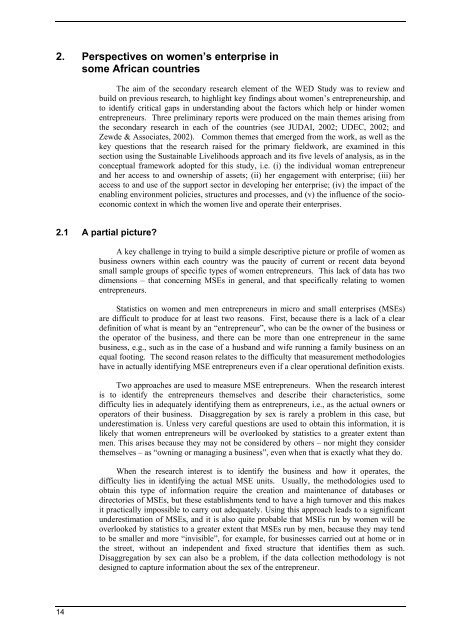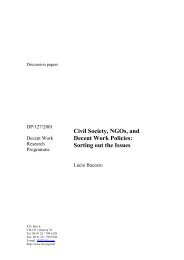The Challenges of Growing Small Businesses - International Labour ...
The Challenges of Growing Small Businesses - International Labour ...
The Challenges of Growing Small Businesses - International Labour ...
Create successful ePaper yourself
Turn your PDF publications into a flip-book with our unique Google optimized e-Paper software.
2. Perspectives on women’s enterprise in<br />
some African countries<br />
<strong>The</strong> aim <strong>of</strong> the secondary research element <strong>of</strong> the WED Study was to review and<br />
build on previous research, to highlight key findings about women’s entrepreneurship, and<br />
to identify critical gaps in understanding about the factors which help or hinder women<br />
entrepreneurs. Three preliminary reports were produced on the main themes arising from<br />
the secondary research in each <strong>of</strong> the countries (see JUDAI, 2002; UDEC, 2002; and<br />
Zewde & Associates, 2002). Common themes that emerged from the work, as well as the<br />
key questions that the research raised for the primary fieldwork, are examined in this<br />
section using the Sustainable Livelihoods approach and its five levels <strong>of</strong> analysis, as in the<br />
conceptual framework adopted for this study, i.e. (i) the individual woman entrepreneur<br />
and her access to and ownership <strong>of</strong> assets; (ii) her engagement with enterprise; (iii) her<br />
access to and use <strong>of</strong> the support sector in developing her enterprise; (iv) the impact <strong>of</strong> the<br />
enabling environment policies, structures and processes, and (v) the influence <strong>of</strong> the socioeconomic<br />
context in which the women live and operate their enterprises.<br />
2.1 A partial picture?<br />
A key challenge in trying to build a simple descriptive picture or pr<strong>of</strong>ile <strong>of</strong> women as<br />
business owners within each country was the paucity <strong>of</strong> current or recent data beyond<br />
small sample groups <strong>of</strong> specific types <strong>of</strong> women entrepreneurs. This lack <strong>of</strong> data has two<br />
dimensions – that concerning MSEs in general, and that specifically relating to women<br />
entrepreneurs.<br />
Statistics on women and men entrepreneurs in micro and small enterprises (MSEs)<br />
are difficult to produce for at least two reasons. First, because there is a lack <strong>of</strong> a clear<br />
definition <strong>of</strong> what is meant by an “entrepreneur”, who can be the owner <strong>of</strong> the business or<br />
the operator <strong>of</strong> the business, and there can be more than one entrepreneur in the same<br />
business, e.g., such as in the case <strong>of</strong> a husband and wife running a family business on an<br />
equal footing. <strong>The</strong> second reason relates to the difficulty that measurement methodologies<br />
have in actually identifying MSE entrepreneurs even if a clear operational definition exists.<br />
Two approaches are used to measure MSE entrepreneurs. When the research interest<br />
is to identify the entrepreneurs themselves and describe their characteristics, some<br />
difficulty lies in adequately identifying them as entrepreneurs, i.e., as the actual owners or<br />
operators <strong>of</strong> their business. Disaggregation by sex is rarely a problem in this case, but<br />
underestimation is. Unless very careful questions are used to obtain this information, it is<br />
likely that women entrepreneurs will be overlooked by statistics to a greater extent than<br />
men. This arises because they may not be considered by others – nor might they consider<br />
themselves – as “owning or managing a business”, even when that is exactly what they do.<br />
When the research interest is to identify the business and how it operates, the<br />
difficulty lies in identifying the actual MSE units. Usually, the methodologies used to<br />
obtain this type <strong>of</strong> information require the creation and maintenance <strong>of</strong> databases or<br />
directories <strong>of</strong> MSEs, but these establishments tend to have a high turnover and this makes<br />
it practically impossible to carry out adequately. Using this approach leads to a significant<br />
underestimation <strong>of</strong> MSEs, and it is also quite probable that MSEs run by women will be<br />
overlooked by statistics to a greater extent that MSEs run by men, because they may tend<br />
to be smaller and more “invisible”, for example, for businesses carried out at home or in<br />
the street, without an independent and fixed structure that identifies them as such.<br />
Disaggregation by sex can also be a problem, if the data collection methodology is not<br />
designed to capture information about the sex <strong>of</strong> the entrepreneur.<br />
14
















